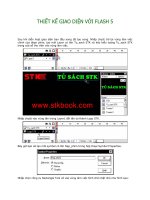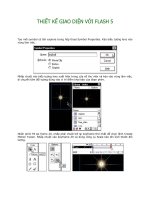THIẾT KẾ GIAO DIỆN TRÊN ANDROID Bài 6: Dialog –Input KeyboardSearch
Bạn đang xem bản rút gọn của tài liệu. Xem và tải ngay bản đầy đủ của tài liệu tại đây (565.54 KB, 32 trang )
THIẾT KẾ GIAO DIỆN TRÊN
ANDROID
Bài 6: Dialog –Input
Keyboard-Search
Nội dung bài học
1. Toast & AlertDialog
2. Input Keyboard
3. Search
2
1. Toast & Alert Dialog
Sử dụng Toast và Alert Dialog để kiểm tra một điều gì đó, hay
đơn giản chỉ là xuất thông báo.
Cả Toast và Alert Dialog khi hiển thị lên thì các tiến trình (hay
các lệnh) khác vẫn cứ tiếp tục làm việc.
1. Toast & Alert Dialog
a) Toast
Có thể sử dụng trong trường hợp hiển thông báo trong các
mục thiết lập thông số cấu hình, hay đơn giản chỉ là hiển thị
lên để xem thông tin tạm thời nào đó (giống như để kiểm
tra một vấn đề xảy ra chẳng hạn).
Toast có thể được tạo và hiển thị trong Activity hoặc trong
Servive.
Có thể thiết lập vị trí hiển thị toast.
Ví dụ: Toast sẽ xuất hiện ở góc bên
trái, trên cùng ta viết như sau:
toast.setGravity(Gravity.TOP|Gravity.LEFT, 0, 0);
1. Toast & Alert Dialog
a) Toast (tiếp)
Không cho phép người sử dụng tương tác
Khi hiển thị sau khoảng thời gian nào đó sẽ tự đóng lại.
Có 2 giá trị mặc định (ta nên sử dụng 2 giá trị này, không nên
gõ con số cụ thể vào):
Toast.LENGTH_SHORT hiển thị trong 2 giây,
Toast.LENGTH_LONG hiển thị trong 3.5 giây.
Cách định nghĩa một Toast:
Context context = getApplicationContext();
CharSequence text = "Hello toast!";
int duration = Toast.LENGTH_SHORT;
Toast toast = Toast.makeText(context, text, duration);
toast.show();
1. Toast & Alert Dialog
a) Toast (tiếp): Tạo một Custom Toast
Tạo một tệp toast_layout.xml
android:id="@+id/toast_layout_root"
android:orientation="horizontal"
android:layout_width="fill_parent"
android:layout_height="fill_parent"
android:padding="8dp"
android:background="#DAAA"
>
android:layout_height="wrap_content"
android:layout_marginRight="8dp"
/>
android:layout_height="wrap_content"
android:textColor="#FFF"
/>
</LinearLayout>
1. Toast & Alert Dialog
a) Toast (tiếp): Tạo một Custom Toast
Sử dụng custom toast bằng cách gọi id: toast_layout_root
LayoutInflater inflater = getLayoutInflater();
View layout = inflater.inflate(R.layout.custom_toast,
(ViewGroup) findViewById(R.id.toast_layout_root));
TextView text = (TextView) layout.findViewById(R.id.text);
text.setText("This is a custom toast");
Toast toast = new Toast(getApplicationContext());
toast.setGravity(Gravity.CENTER_VERTICAL, 0, 0);
toast.setDuration(Toast.LENGTH_LONG);
toast.setView(layout);
toast.show();
1. Toast & Alert Dialog
b) Alert Dialog
Hiển thị và cho phép người dùng
tương tác,
Ví dụ như hình bên dưới, khi nhấn
nút “Cancel”, chương trình sẽ hiển thị
Alert Dialog hỏi xem có chắc chắn
muốn xóa hay không? Bấm No thì
không, bấm Yes thì tắt chương trình.
1. Toast & Alert Dialog
b) Alert Dialog (tiếp)
Cách tạo Alert Dialog:
AlertDialog.Builder b=new AlertDialog.Builder(YourActivity.this);
b.setTitle(“Question”);
b.setMessage(“Are you sure you want to exit?”);
b.setPositiveButton(“Yes”, new DialogInterface. OnClickListener()
{
@Override
public void onClick(DialogInterface dialog, int which)
{
finish();
}});
b.setNegativeButton(“No”, new DialogInterface.OnClickListener()
{
@Override
public void onClick(DialogInterface dialog, int which)
{
dialog.cancel();}
});
b.create().show();
1. Toast & Alert Dialog
b) Alert Dialog (tiếp)
Ý nghĩa của các hàm :
• setTitle : thiết lập tiêu đề cho Dialog
• setMessage: thiết lập nội dung cho Dialog
• setIcon : thiết lập Icon
• setPositiveButton, setNegativeButton thiết lập hiển
thị nút chọn cho Dialog. Chú ý là ở đối số thứ 2 của các
hàm này sẽ là DialogInterface.OnClickListener chứ
không phải View.OnClickListener
• create() để tạo Dialog
• show() để hiển thị Dialog.
1. Toast & Alert Dialog
Demo Toast & Alert Dialog
2. Input Keyboard
TextField:
TextField cho phép nhập nội dung text vào ứng dụng.
Khi đưa con trỏ vào ô nhập, một loại keyboard sẽ tự động
hiển thị.
Ngoài ra, text fields cũng cho phép thực hiện các hoạt
động khác như: copy, cut, paste và tìm kiếm dữ liệu…
Sử dụng thẻ <EditText>
2. Input Keyboard
(1)Keyboard Type
TextFields có thể nhập nhiều loại khác nhau: number, date,
password, email, adress..
Với mỗi kiểu sẽ hiển thị dạng keyboard khác nhau.
Ta có thể sử dụng thuộc tính android:inputType trong thẻ
EditText để khai báo loại dữ liệu nhập :
android:layout_width="fill_parent"
android:layout_height="wrap_content"
android:hint="@string/email_hint"
android:inputType="textEmailAddress" />
2. Input Keyboard
(1)Keyboard Type
android:inputType =“….”
"text" : bàn phím text thông thường.
"textEmailAddress“: nhập text có chứa
ký tự @ ở keyboard
"textUri“ : nhập text có chứa ký tự /
"number" : keyboard có chứa dạng số.
"phone“: keyboard có dạng kiểu phone
để nhập số điện thoại.
2. Input Keyboard
(1)Keyboard Type
Một số thuộc tính thông dụng khác:
"textCapSentences“: viết hoa đầu mỗi câu
"textCapWords“: viết hoa đầu mỗi từ. Ví dụ như họ tên
"textAutoCorrect" : tự động chỉnh lỗi chính tả.
"textPassword”: ký tự nhập vào chuyển sang dạng “.”
"textMultiLine“: nhập ký tự dài.
android:layout_width="fill_parent"
android:layout_height="wrap_content"
android:hint="@string/postal_address_hint"
android:inputType="textPostalAddress|textCapWords| textNoSuggestions" />
2. Input Keyboard
(2)Keyboard Actions: định nghia một Keyboard Action
Cho phép hiển thị một số action như Search, Send sau khi
nhập xong sẽ sử dụng.
Sử dụng thuộc tính android:imeOptions = “actionSend”
hoặc “actionSearch” hoặc “actionNone”
Ví dụ: nếu khai báo thì keyboard sẽ có cả nút Send
android:layout_width="fill_parent"
android:layout_height="wrap_content"
android:hint="@string/search_hint"
android:inputType="text"
android:imeOptions="actionSend" />
2. Input Keyboard
(2)Keyboard Actions: thực hiện hành động của nút action
Cho phép thực hiện hành động của nút action, tùy loại mà
ta khai báo ID khác nhau: IME_ACTION_SEND hoặc
IME_ACITON_SEARCH:
EditText editText = (EditText) findViewById(R.id.search);
editText.setOnEditorActionListener(new OnEditorActionListener()
{
@Override
public boolean onEditorAction(TextView v, int actionId, KeyEvent event) {
boolean handled = false;
if (actionId == EditorInfo.IME_ACTION_SEND) {
sendMessage();
handled = true;
}
return handled;
}});
2. Input Keyboard
(2)Keyboard Actions: tạo một nhãn riêng cho nút action
Sử dụng thuộc tính android:imeActionLabel để tạo nhãn
riêng cho nút action muốn thực hiện
android:layout_width="fill_parent"
android:layout_height="wrap_content"
android:hint="@string/enter_launch_codes"
android:inputType="number"
android:imeActionLabel="@string/launch" />
2. Input Keyboard
(3)Keyboard Flags
Một vài flag được sử dụng với thuộc tính
android:imeOptions
• flagNoFullscreen;
• flagNavigatePrevious;
• flagNavigateNext;
• flagNoExtractUi;
• flagNoAccessoryAction;
• flagNoEnterAction;
• flagForceAscii
Ví dụ: android:imeOptions="flagNoExtractUi“: làm cho màn
hình nhập dữ liệu không bị fullscreen
2. Input Keyboard
Demo Input Keyboard
3. Search
1. Tổng quan về Search
Android cung cấp 2 loại search: search
dialog và search widget
Tính năng sẵn có:
• Tìm kiếm theo voice
• Cung cấp những từ gợi ý sau khi
người dùng nhập vài ký tự.
• Cung cấp từ gợi ý dựa trên dữ liệu
đã xây dựng.
3. Search
a)Tạo một Searchable configuration
Tạo một file searchable.xml trong thư mục /res/xml. Cấu
hình để gán các thuộc tính như: voice search, search
suggestion hoặc hint text cho hộp thoại search.
Ví dụ:
<?xml version="1.0" encoding="utf-8"?>
android:hint="@string/search_hint”
android:searchSuggestAuthority="dictionary"
android:searchSuggestIntentAction="android.intent.action.VIEW"
android:includeInGlobalSearch="true"
android:searchSettingsDescription="@string/settings_description" >
</searchable>
3. Search
b)Tạo một Searchable Activity
(1)Khai báo searchable activity
Khai báo activity để chấp nhận ACTION_SEARCH và thẻ
<intent-filter>
Chỉ định thẻ searchable để sử dụng, được định nghĩa trong
thẻ <meta-data>
<application ... >
<activity android:name=".SearchableActivity" >
<intent-filter>
<action android:name="android.intent.action.SEARCH" />
</intent-filter>
</activity>
</application>
3. Search
b)Tạo một Searchable Activity
(2)Thực hiện search: 3 bước
Bước 1:Receiving the query
@Override
public void onCreate(Bundle savedInstanceState) {
super.onCreate(savedInstanceState);
setContentView(R.layout.search);
// Get the intent, verify the action and get the query
Intent intent = getIntent();
if (Intent.ACTION_SEARCH.equals(intent.getAction())) {
String query = intent.getStringExtra(SearchManager.QUERY);
doMySearch(query);
}}
Ở ví dụ trên, chuỗi truy vấn được lấy ra và truyền vào
phương thức doMySearch() để thực hiện hành động tìm kiếm
3. Search
b)Tạo một Searchable Activity
Bước 2: Searching your data
Ta có thể khai báo chuỗi gợi ý cho tìm kiếm bằng cách sử dụng
ArrayAdapter như đã học ở bài trước.(ListView)
Bước 3: Presenting the results
Hiển thị kết quả tìm kiếm bằng cách sử dụng ListView









